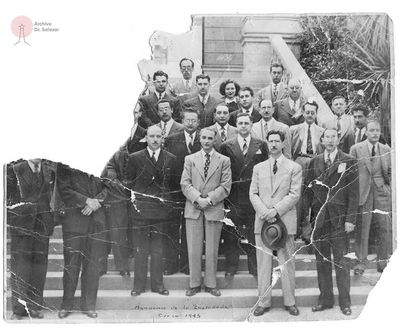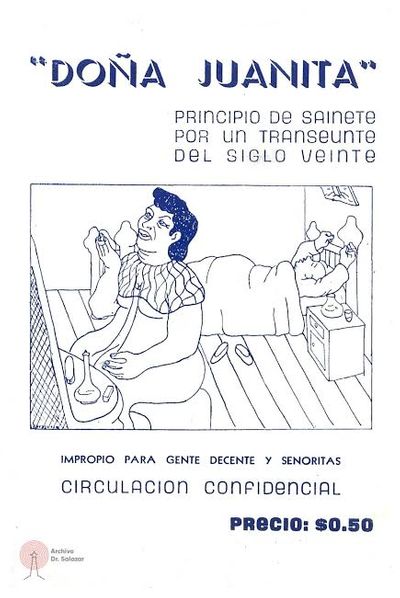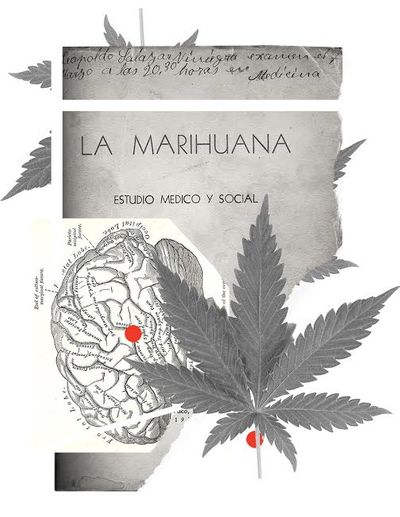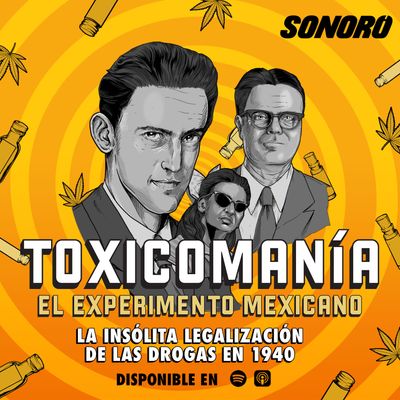
Meet the revolutionary doctor who legalized drugs in Mexico in 1940
Dr. Leopoldo Salazar Viniegre (Courtesy of the archives of Dr. Salazar)
The endless process of legalizing cannabis in Mexico often gives the impression that prohibition is going nowhere. But Magali Ocaña Salazar wants to remind everyone of an important piece of almost forgotten history: her grandfather helped legalize all drugs in Mexico – in 1940.
Dr. Leopoldo Salazar Viniegra was born in the northern state of Durango and was a pioneer in the global drug decriminalization and harm reduction movement. Salazar’s work laid the groundwork for Mexico’s short-lived experiment to legalize drugs in 1940. It ended when the US government – and infamous anti-drug tsar Harry Anslinger – intervened just months after the program started.
Now Ocaña is on a mission to revive the memory of her grandfather’s legacy.
“I don’t know if it’s our people or our government, but anyone doesn’t want us to think we can be autonomous [or] innovative, ”said Ocaña. (All of the interviews for this story were originally conducted on my Spanish-language cannabis radio show, Crónica.) “These days people say, ‘We should follow the example of the United States or Uruguay.’ No! In 1938 these ideas were formulated in Mexico. “
Ocaña has set himself the task of creating an accessible digital archive of Salazar’s texts, including the columns he wrote between 1938 and 1957 for the Excelsior and El Universal newspapers under the name “El Alienista” or “The Alienist”. She even collects pieces by intrepid historians and writers like Froylán Enciso, Nidia Olvera Hernández, and Ricardo Pérez Montfort, who also helped uncover Salazar’s accomplishments.
Salazar’s story began when he fell in love with psychiatry while studying in Spain and France in the 1920s. Upon his return home, the man who was eventually dubbed “the Mexican Freud” by the now-defunct magazine 4to Poder was appointed director of the Castañeda Asylum in Mexico City, known locally as the “House of Madness”.
The Salazar family (courtesy of Dr. Salazar’s archives)
For decades he lived with his second wife and three children in one of the doctors’ chalets on the premises. The Salazar children have rosy memories of this strange home. Ocaña’s uncle Leopoldo Jr. told her stories about playing Horsey with the country’s first publicized serial killer, Goyo Cárdenas, also known as “the strangler of Tacuba”. Cárdenas brutally murdered underage sex workers, but was pardoned by the president for his terrible crimes in 1976 after studying law and music in the mental hospital. The killer eventually became a practicing lawyer and the inspiration for director Alejando Jodorowsky’s film Santa Sangre.
Given the brutal treatment of the mentally ill in the 1930s, Salazar’s humanistic approach was astounding. The institution’s files contain an official complaint requesting that patients be allowed to leave the hospital premises on their own. Ocaña’s family even speaks of allowing asylum seekers to leave the premises to buy marijuana.
Salazar and his family also hired patients to work for them. His wife, who was a scientist, hired an inpatient as a laboratory assistant. Another patient worked as a nanny for her children.
Castañeda asylum workers in 1945; Dr. Salazar in a Polka Dot Tie (Courtesy of Dr. Salazar’s archives)
“His approach [drug users], or anyone who was sick was completely different from the rest of the era, ”says Ocaña. “He didn’t give an electric shock, he tried to understand the stories of her life, her addiction, on a scientific level and not through moral judgments.”
Salazar developed a keen interest in addiction. He insisted that drug users should be treated as patients, not criminals. He believed that their welfare depended on the government wrestling control of the supply and distribution of illegal substances away from abusive drug dealers and corrupt police officers.
In the case of cannabis, Salazar argued that, despite the widespread propaganda of the era, the drug did not induce criminal or psychotic behavior. In 1938 he wrote a play in which he compared marijuana to a harmless old woman named Doña Juanita. The cover of the published script even had a cheeky slogan: “Inappropriate for decent people”.
Cover of Salazar’s play “Dona Juanita” from 1938 (courtesy of the archives of Dr. Salazar)
The piece had an impact then and is still relevant today. In fact, Mexican Senator Jesusa Rodríguez staged the play in the Senate at the time lawmakers were considering legalizing cannabis in 2020. But Doña Juanita is not Salazar’s only permanent job. He also wrote an essay that is now famous among decriminalization advocates entitled “El Mito de Marihuana” or the “Myth of Marijuana”.
Salazar even researched the drug’s effects on his own colleagues in an attempt to refute the common misconception that marijuana causes madness. El Universal reported that Salazar once handed out joints to medical colleagues at a presentation of “El Mito”.
“My grandfather’s perspective always said, ‘Take marijuana out of this category along with morphine and heroin,” says Ocaña. “It is not practicable on a scientific level.”
Salazar was eventually appointed head of the country’s addiction programs – and head of law enforcement’s fight against drug traffickers – at the Federal Ministry of Health. His archives contain a public letter he wrote to the notorious CDMX drug trafficker Lola “La Chata” acknowledging the widespread corruption among the Mexican police.
In a rare in-depth newspaper interview published in 1938, the doctor suggested a program where medical professionals would regularly administer drugs through pharmacies. A year later, his team presented the same plan to the United Nations Opium Advisory Committee. The US government poked fun at the program, arguing that it could increase the flow of illicit drugs from Mexico to the United States.
However, on February 17, 1940, the government of President Lázaro Cárdenas made fundamental changes to the federal drug ordinance, inspired by the work of Salazar and other doctors at the Ministry of Health. The new, revolutionary plan would lift criminal penalties for drug use and allow state-run pharmacies to administer morphine to people with addiction problems (mainly opiates) at cost. (Information on other drugs covered by the plan is limited.) The drug addiction department at Salazar Mental Hospital was closed because this harm reduction approach allowed addicts to lead relatively normal lives.
“One of my grandfather’s main theories was that ‘the forbidden is the most seductive,'” says Ocaña. “When you stop banning a substance, society begins to think about it differently.”
Image by Marina Corach for the archive of Dr. Salazar
But the doctor was removed from his government post before he could oversee the implementation of his ideas. In 1940 Mexico held a controversial and violent presidential election. Salazar has been implicated in opposition to the presidential election and was unceremoniously fired before the pharmacies were opened to the public.
Despite the fact that the pharmacy program came into being without its main architect, the sites were popular according to the limited documentation that survived. A location on Seville Street in Juárez, a central area of Mexico City, attracted around 500 patients a day, reports Froylán Enciso in his book Nuestra Historía Narcótica [Our Narcotic History.]
Unfortunately, the big experiment was short-lived. Just four months after the creation of the program, President Cárdenas suspended the regulations on June 7, 1940, blaming the supply chain of the drugs necessary for stocking pharmacies for complications from the Second World War.
What actually happened is that the US government intervened. Anslinger had telegrams sent to President Cárdenas threatening to stop exporting pharmaceuticals to Mexico if the country did not uphold the drug ban. Cárdenas tried to negotiate; no dice.
The forced end to this brief experiment with drug legalization in Mexico had very real historical ramifications. The country’s resumed drug war would develop into a bloody scourge over time: According to official figures, 79,000 people have disappeared due to cartel crimes since December 2020, if not dismantled by Anslinger.
After leaving his government post, the doctor focused on education and designed and managed an innovative school for children with behavioral problems called Casa Sin Rejas, or the “House Without Bars,” where students developed their own curriculum. After his death, Salazar’s iconoclastic legacy, remembered primarily by committed drug legalization advocates and well-read psychiatry and psychology students, faded.
Ad on “drug addiction”
Fortunately, Ocaña has powerful allies to assist her in her quest to revive Salazar’s legacy. In April, a star-studded cast and crew launched a fictional podcast that focused on the doctor’s legalization experiment. Toxicomanía (which translates as “Substance Addiction”) was created by one of Mexico’s most famous actors – the star of Netflix’s first Spanish original production, Club de Cuervos – Luis Gerardo Méndez, who is also Dr. Salazar plays, co-produces. In the Spanish-language series, Anslinger is played by Rainn Wilson, known to many as Dwight Schrute from the TV show The Office. Ocaña is listed as a consultancy producer.
“I want this series to dilate people’s pupils as best as possible,” says Andres “Ruzo” Vargas, director of Toxicomanía. “Salazar should be part of Mexican tradition. He should have named at least one street, one alley, one hospital after him. Out of our curiosity about it, the idea to tell his story arose. ”This intrigue seems contagious – the show rose to number one on the country’s Spotify podcast chart when it was released on April 20th. made his debut and stayed at the top for two weeks.
Ocaña believes her grandfather believed in humanity’s potential for change – and that his ideas could prove useful at a time when many are pondering options following the failure of the global drug ban.
“I think his work could help people imagine a different future.”





Post a comment: